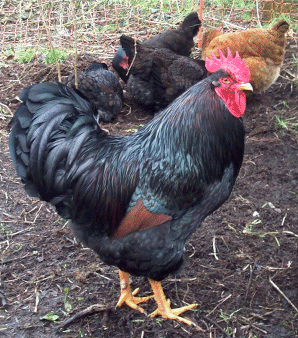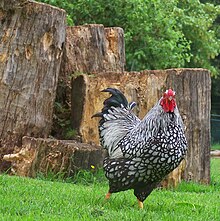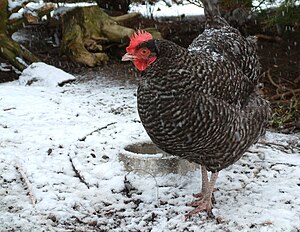
The Barnevelder is a Dutch breed of domestic chicken. It resulted from cross-breeding between local Dutch chickens and various “Shanghai” birds imported from Asia to Europe in the later part of the nineteenth century; these may have been of Brahma, Cochin or Croad Langshan type.[1] It is named for the town and gemeente (municipality) of Barneveld, in Gelderland in the central Netherlands. The hens are good layers of large brown eggs and, unlike some other breeds, continue to lay well during winter.

The Rhode Island Red is an American breed of domestic chicken. It was developed in the late nineteenth century in Massachusetts and Rhode Island by cross-breeding birds of Oriental origin such as the Malay with brown Leghorn birds from Italy. It was formerly a dual-purpose breed, raised both for meat and for eggs; modern strains have been bred for their egg-laying abilities.

The Welsummer or Welsumer is a Dutch breed of domestic chicken. It originates in the small village of Welsum, in the eastern Netherlands. It was bred at the beginning of the 20th century from local fowls of mixed origin: Rhode Island Reds, Barnevelders, Partridge Leghorns, Cochins, and Wyandottes.

The Leghorn (/ˈlɛɡhɔːrn/ or UK /lɛˈɡɔːrn/; Italian: Livorno or Livornese) is a breed of chicken originating in Tuscany, in central Italy. Birds were first exported to North America in 1828 from the port city of Livorno,[3] on the western coast of Tuscany. They were initially called “Italians”, but by 1865 the breed was known as “Leghorn”, the traditional anglicisation of “Livorno”.

The Australorp is a chicken breed of Australian origin, developed as utility breed with a focus on egg laying. It is considered the honorary National Chicken Breed of Australia,[4] and the most popular colour of the breed is black, which is the only colour recognised in the United States of America,[3] but blue and white are also recognised in its home country[5] and the Poultry Club South Africa recognises buff, splash, wheaten laced and golden in addition.[6]

The Orpington is a breed of chicken named after the town of Orpington, Kent, in south-east England.[3] It was bred to be an excellent layer with good meat quality.[3] Its large size and soft appearance together with its rich colour and gentle contours make it very attractive, and as such its popularity has grown as a show bird rather than a utility breed. Hens often become broody and are good mothers. Although rather heavy, they are able to fly small distances but rarely do so.[4]

The Wyandotte is a breed of chicken originating in the United States. The first examples of the breed appeared in the 1870s. Wyandottes are a docile, dual-purpose breed kept for their brown eggs and for meat. They appear in a wide variety of color patterns, and are popular show birds. The Wyandotte lays pale brown or tan eggs and usually has a white ring of feathers around its neck.
Coucou Maran (sometimes “Cuckoo Maran” )

The Marans, French: Poule de Marans, is a breed of chicken from the port town of Marans, in the département of Charente-Maritime, in the Poitou-Charentes region of western France. It was created with the local feral chickens descended from fighting game chickens carried from Indonesia and India. Those original Marandaise fowl were “improved” for the table through recombination with imported Croad Langshans. it is a dual purpose fowl known both for its extremely dark eggs and fine meat qualities.

Ameraucana (or “Easter Egger“)
The Ameraucana is an American breed of domestic chicken developed in the United States in the 1970s. It was derived from chickens brought from South America that carried the blue egg gene, and was bred to maintain the blue egg color of that breed while eliminating the lethal recessive gene
An Easter Egger is any chicken that possesses the “blue egg” gene, but doesn’t fully meet any breed standard defined in the American Poultry Association’s (APA) standards, or in the case of Easter Egger bantams, the American Bantam Association’s (ABA) standards. The name derives from the resemblance of their colorful eggs to Easter eggs. The Araucana, Ameraucana, and Easter Egger are descended from the same founder stock that spread around the world from Chile and the Falklands.